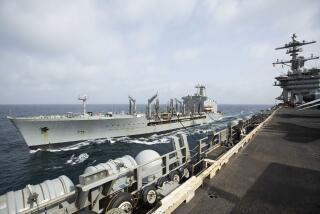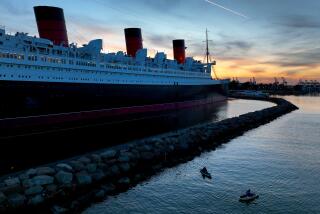That rust on your shower head? It’s a $6-billion problem for the Navy, cruise ships and more
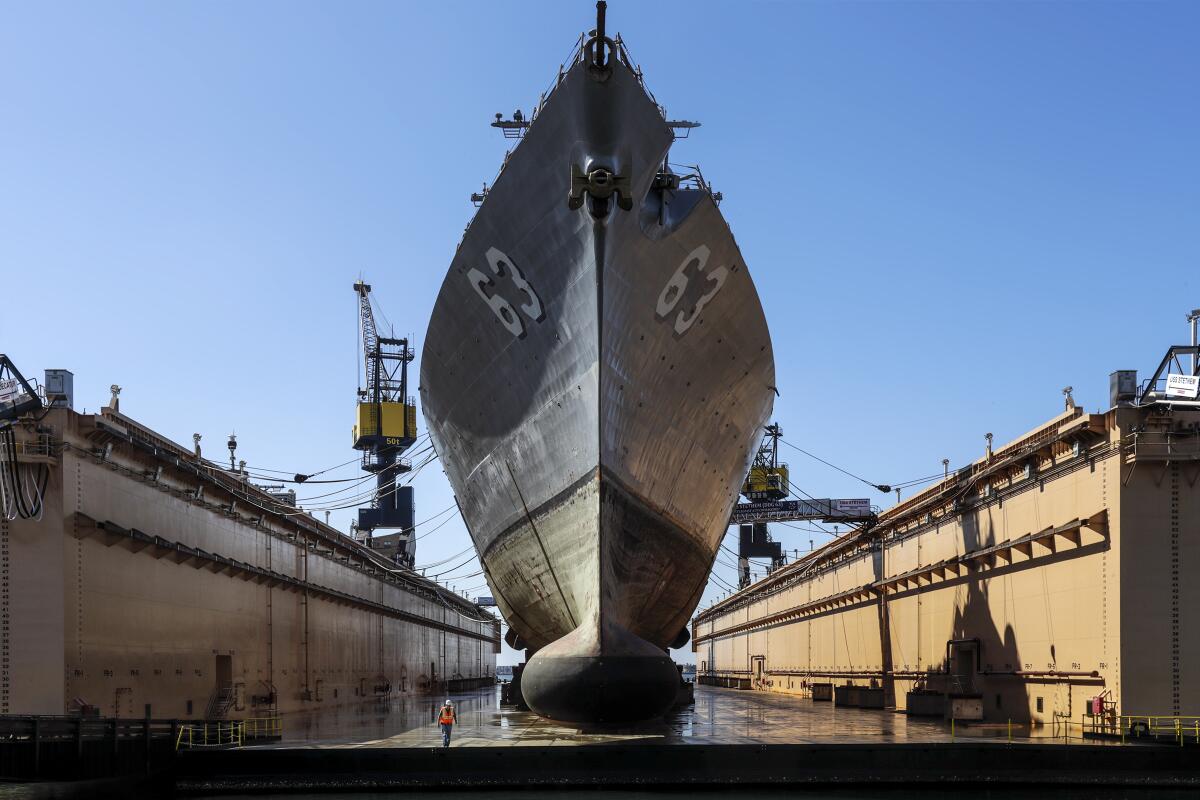
It’s a $6-billion scourge that afflicts Navy destroyers, cruise ships and historic vessels like the Queen Mary without fear or favor.
It’s such a problem that professional organizations and conferences are dedicated to its existence — and its suppression.
It’s also on your shower head.
The orange stain of metal corrosion may be a nuisance in the bathroom, but on ships, it can be catastrophic. Hulls can collapse, ballast tanks weaken and motors fail, all because of rust. There’s no way to fully eradicate it.
The only option: constant vigilance.
“Ships are full of saltwater systems, they’re full of salty ocean air,” said Scott Tait, a retired Navy captain who most recently was at the helm of the guided-missile destroyer Zumwalt. “Corrosion through the entire ship is a huge, huge issue.”
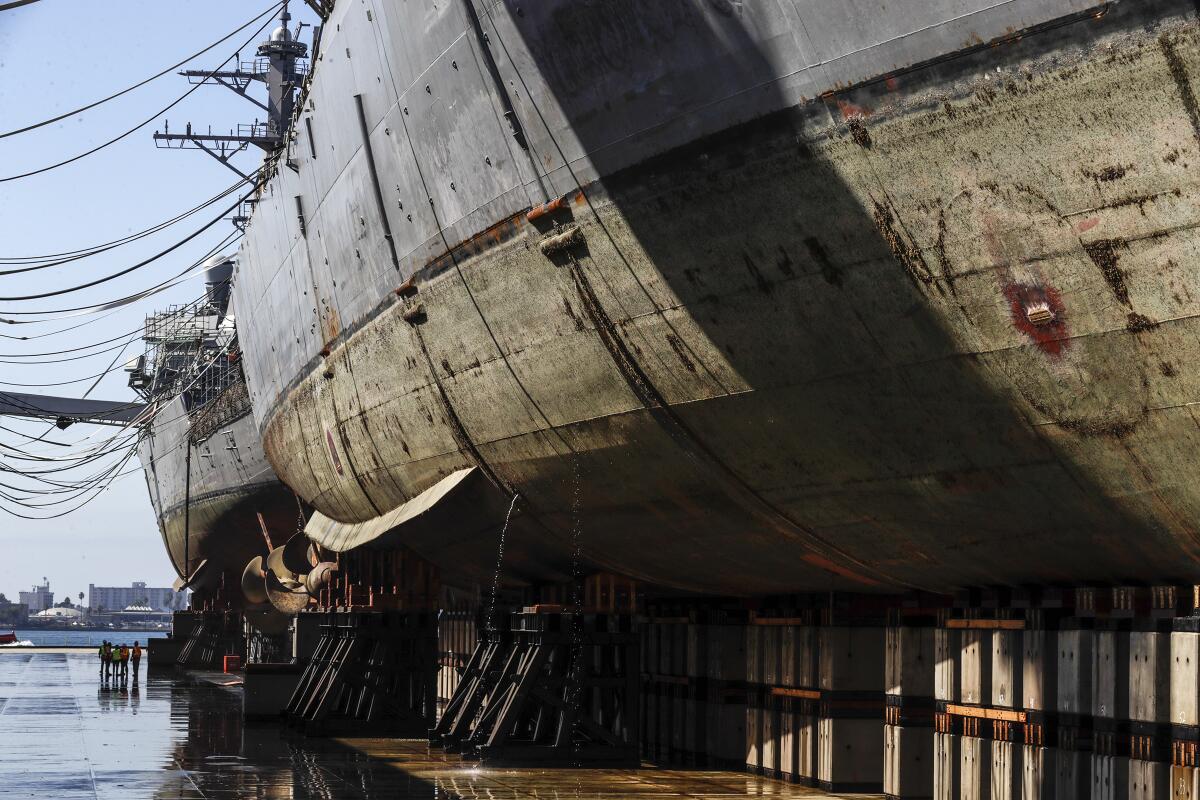
Humanity has been battling rust since people first began using metal for their own purposes. The Bible talks about it, as do Greek and Roman writings and works by William Shakespeare, said Jonathan Waldman, author of the book “Rust: The Longest War.” He describes rust as “the most destructive natural disaster on Earth.”
The damage caused by wildfires and earthquakes is immediate and unmistakable. But the wide-ranging deterioration wrought by rust is “far greater,” he said, even if it doesn’t always make headlines.
Waldman ticks off the toll of corrosion: plane crashes, bridge collapses, countless cars falling apart and a near-accident at a nuclear reactor.
“What rust has done is almost limitless,” he said.
So what exactly is this pervasive vexation? Rust is the result of a chemical reaction between air, water and iron — which is a major component of steel. Add salt water to the mix, and corrosion accelerates.
Coating the metal with a substance — effectively separating it from the water and air — is one way to slow its progress.
One of the earliest methods to prevent rust was greasing metal ship parts with lanolin, a natural oil that comes from sheep wool. In the 1880s, American workers reassembling the Statue of Liberty used shellacked asbestos cloth to separate the statue’s copper exterior from its iron framework, thus preventing corrosion. But as the cloth aged and the shellac dried, the cloth absorbed moisture and rust proliferated.
Today’s methods are a little more complex.
An annual conference called MegaRust brings together hundreds of professionals who want to see the latest corrosion-fighting techniques and tech. Live demonstrations of sandblasters are a highlight. People still talk about the year an exhibitor showed off a laser.
But rust prevention itself has consequences. For regular maintenance, a ship must be brought to a dry dock, a special facility with high walls where ships are lifted out of the water.
Navy ships typically go to a dry dock every five to seven years for repairs and maintenance, including paint restoration, and ships used for freight transport usually go five years between dry dock sessions. For ships that carry commercial cargo, every day spent in dry dock is a day not spent bringing in revenue.
“It’s kind of a double whammy,” said Lars Robert Pedersen, deputy secretary general of BIMCO, an international shipping trade association.
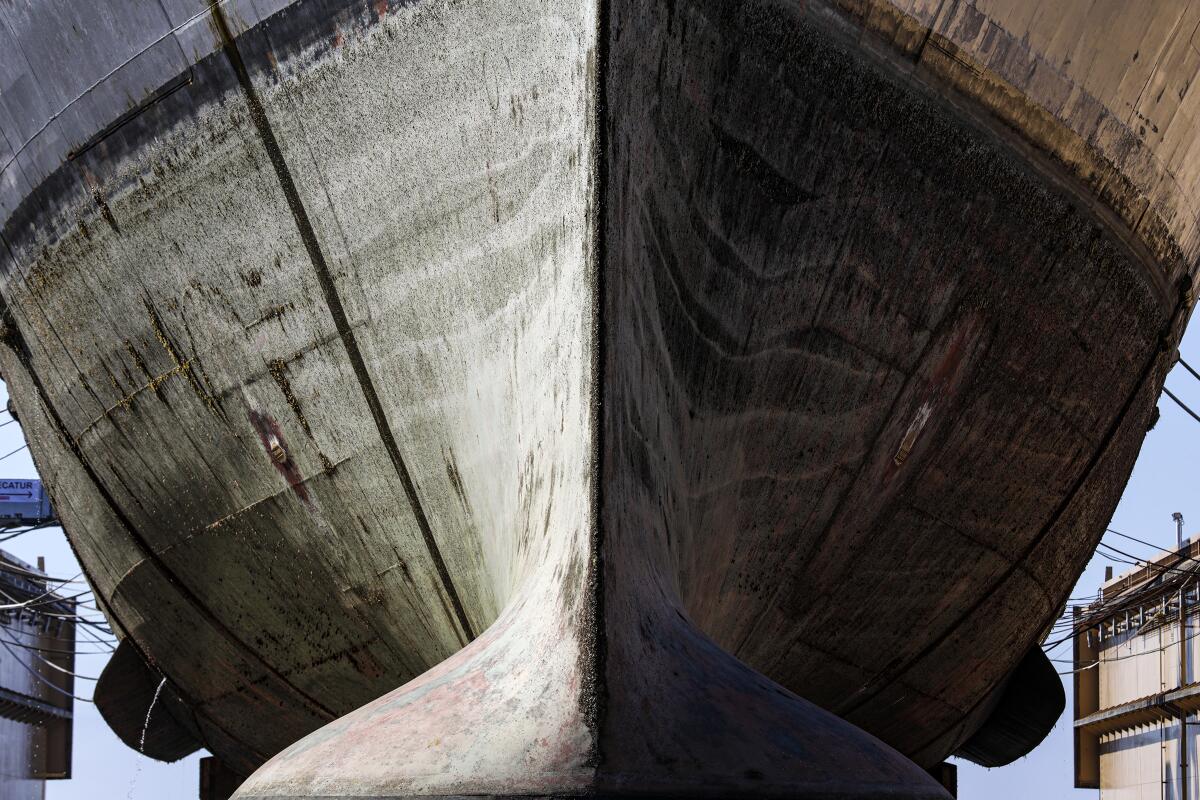
At the same time, ships that go without maintenance for longer periods are more likely to develop corrosion problems along the waterline — an especially vulnerable place since it’s where the seawater and air meet. Rust burgeons. Ignoring corrosion can mean serious problems in just a few years.
“If it’s not dealt with, the cost of going back and trying to correct things that should have been dealt with early can become exorbitant,” said Bradley Martin, senior policy researcher at Rand Corp. and a retired Navy captain.
To tackle this never-ending cycle, the Navy uses paints designed to discourage rust on parts of the ship exposed to the water, including the hull and tanks. Corrosion typically forms where paint gets damaged. When anchors bump against the hulls, that often creates an opportunity for rust.
“The saying down here is: Paint is what holds the fleet together,” said Bill Young, a San Diego-based business unit leader for International Marine and Industrial Applicators, which repairs and primes ship surfaces.
On the bottom of ship hulls, the Navy uses a special epoxy-based red paint to prevent rust and limit barnacle growth. The color is easier for divers to see and indicates to maintenance crews where the underwater hull ends and the upper part begins. But like all things, over time, its luster fades.
This fall, the guided-missile destroyers Stethem and Decatur sailed into a San Diego port to undergo regular maintenance. When the ships were lifted out of the water and settled into a dry dock, the weathering of the hulls was obvious.
The redness on the Decatur’s hull was still visible, but the bottom of the Stethem looked more like sand art, with ripples of faded red, green-gray and black. Brown barnacles marched up its side. Dashes of orange rust formed a stripe, like a lane line on a freeway.
For the cruise ship industry, rust isn’t just a maintenance issue, particularly when those ships are white.
A rust carbuncle the size of a quarter on the side of a gleaming white ocean liner can bleed, leaving a vertical rust stripe. Those wouldn’t compromise the ship’s structural integrity, but it could be a problem for the cruise’s marketing strategy, said Terry Greenfield, president of NACE International, a professional organization focused on corrosion control. That’s why cruise ships have almost an ongoing effort to catch any kind of rust or degradation early on.
“There’s no confidence in rust,” he said.
Dealing with rust isn’t cheap. According to a 2014 report, the Defense Department has pegged the cost for Navy ships and vessels at $3 billion, close to a quarter of their overall maintenance expenses. (Recent examples: BAE Systems won two Defense Department contracts totaling $170 million for two Navy ships in San Diego.) In an email, the Navy bluntly described corrosion control as a “never-ending challenge.”
Sailors know the feeling firsthand. Traditionally, they don life vests and protective gear, stand on a “paint float” suspended by ropes over the edge of the ship and chip away at rust with hand scrapers or a high-pressure needle gun.
Elsewhere, sailors will look for rust inside the ship.
“It’s necessary, but it’s pretty miserable,” said Tait, the retired Zumwalt captain. “Busting rust is nobody’s favorite thing to do.”
And on-ship maintenance can’t get it all. To really tackle rust, work must be done both on the ship and at a dry dock. After donning several layers of clothing, including coveralls and a protective hood with a breathing apparatus, crews shoot ground-up minerals like copper slag through a blast hose to erase the rust as cleanly as if it were writing on a chalkboard.
The work is hot, dusty and dark. Workers sometimes have to squeeze themselves into tight spaces, surrounded by steel that’s baked by the outside sun.
“You really got to enjoy what you do to work down here,” said Young, who has been preserving ships for 17 years.
Some newer Navy ships, like the Zumwalt-class guided-missile destroyers, are being designed from the start with corrosion in mind. The topside structures of those ships are made of fiberglass composite materials, which do not corrode like steel.
Other ships have a brick-shaped piece of zinc mounted to bare metal — a notion that dates back to the 1800s. The addition of zinc protects the ship’s metal structures from the chemical reaction that results in corrosion. After that brick — known as a sacrificial anode — meets its untimely demise, another is bolted in its place.
But despite best efforts, no ship can outrun rust for long. Not even the Grey Ghost.
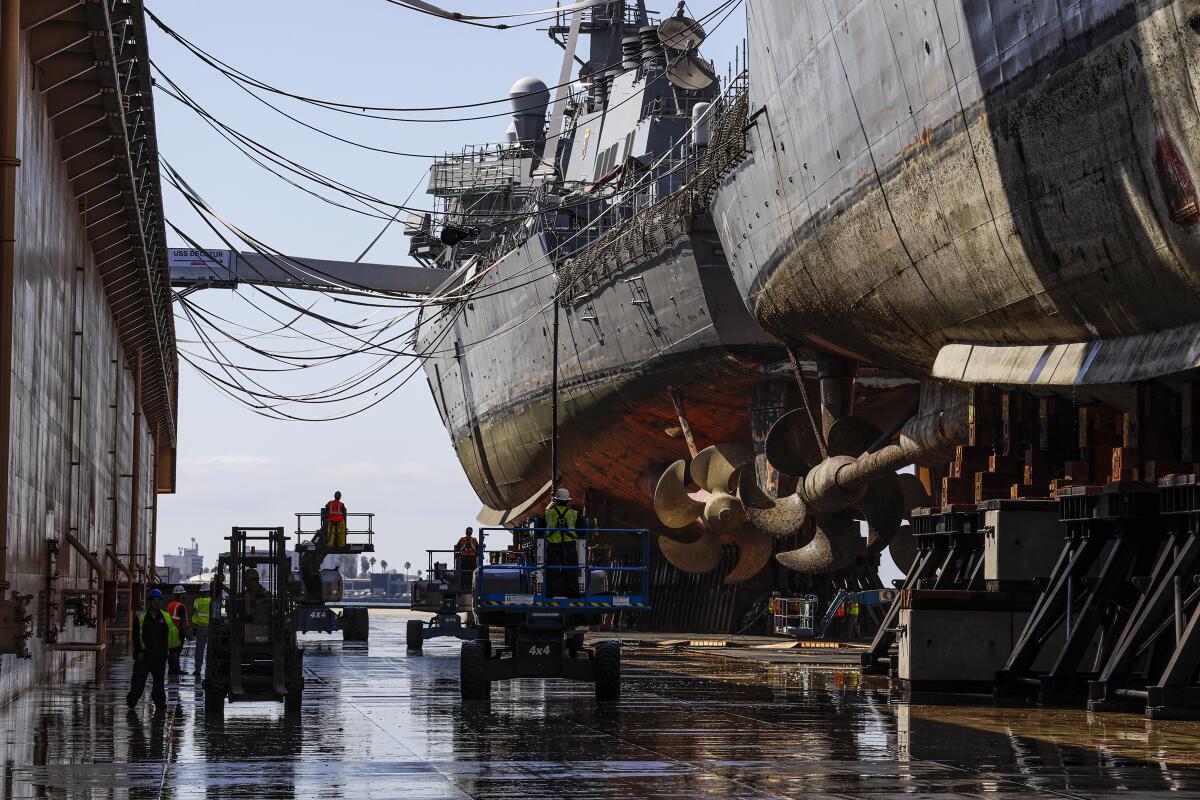
In recent years, corrosion ate away at the Queen Mary to the point that the ship’s internal structure could have collapsed, according to a survey by naval architects and vessel experts. The city of Long Beach spent $23 million on emergency repairs and is now working through other maintenance issues.
“It’s an old boat in salt water, so it’s something we need to direct our attention to,” said Johnny Vallejo, business operations manager of Long Beach’s economic development department. “As you can imagine, it’s never anything that’s fully taken care of.”
That is, of course, unless you’ve embraced the futility of the situation, preferring instead to conserve energy like the languorous Falstaff from Shakespeare’s “Henry IV, Part 2.”
“I were better to be eaten to death with a rust than to be scoured to nothing with perpetual motion,” he says. That, however, is not an option for the U.S. Navy.
More to Read
Inside the business of entertainment
The Wide Shot brings you news, analysis and insights on everything from streaming wars to production — and what it all means for the future.
You may occasionally receive promotional content from the Los Angeles Times.
